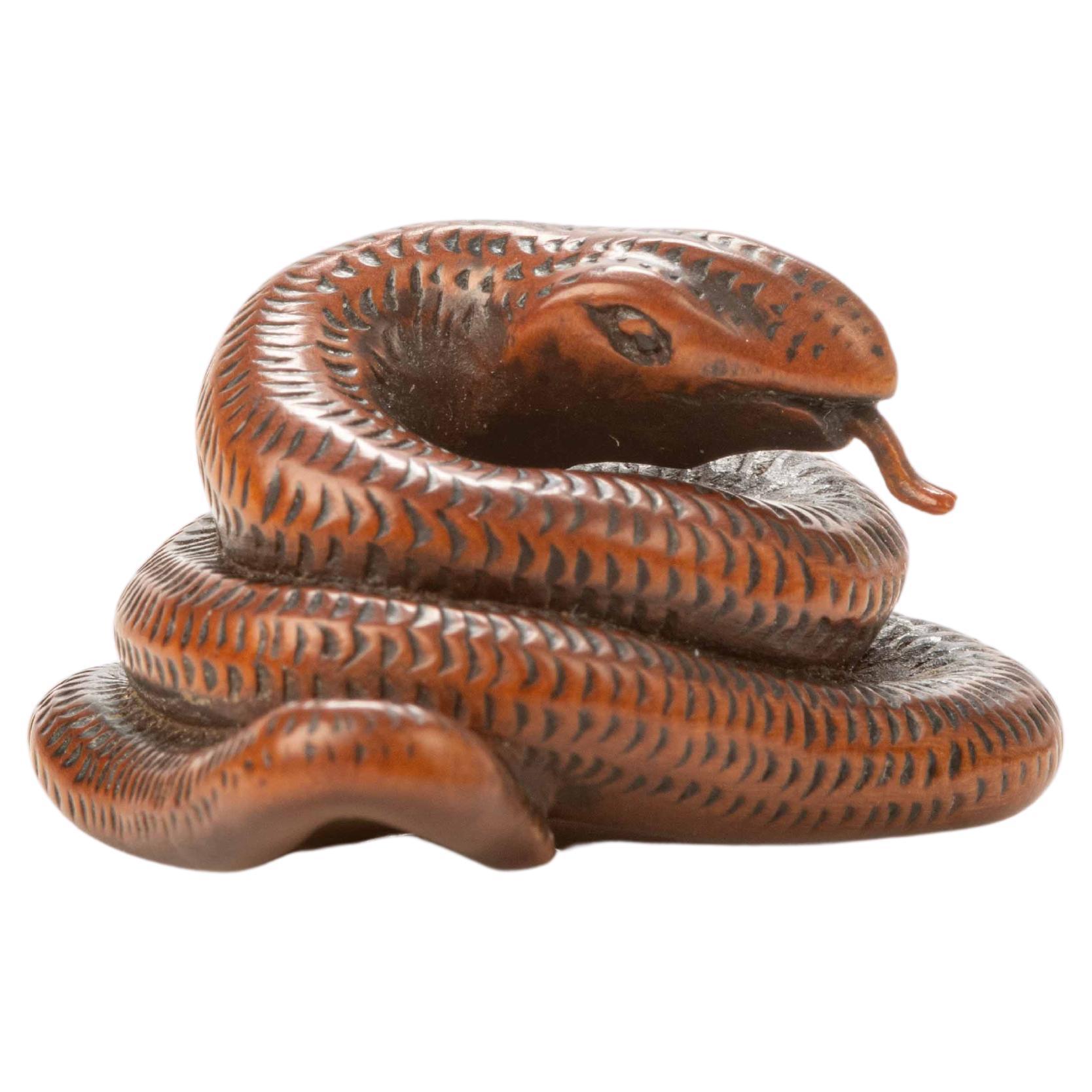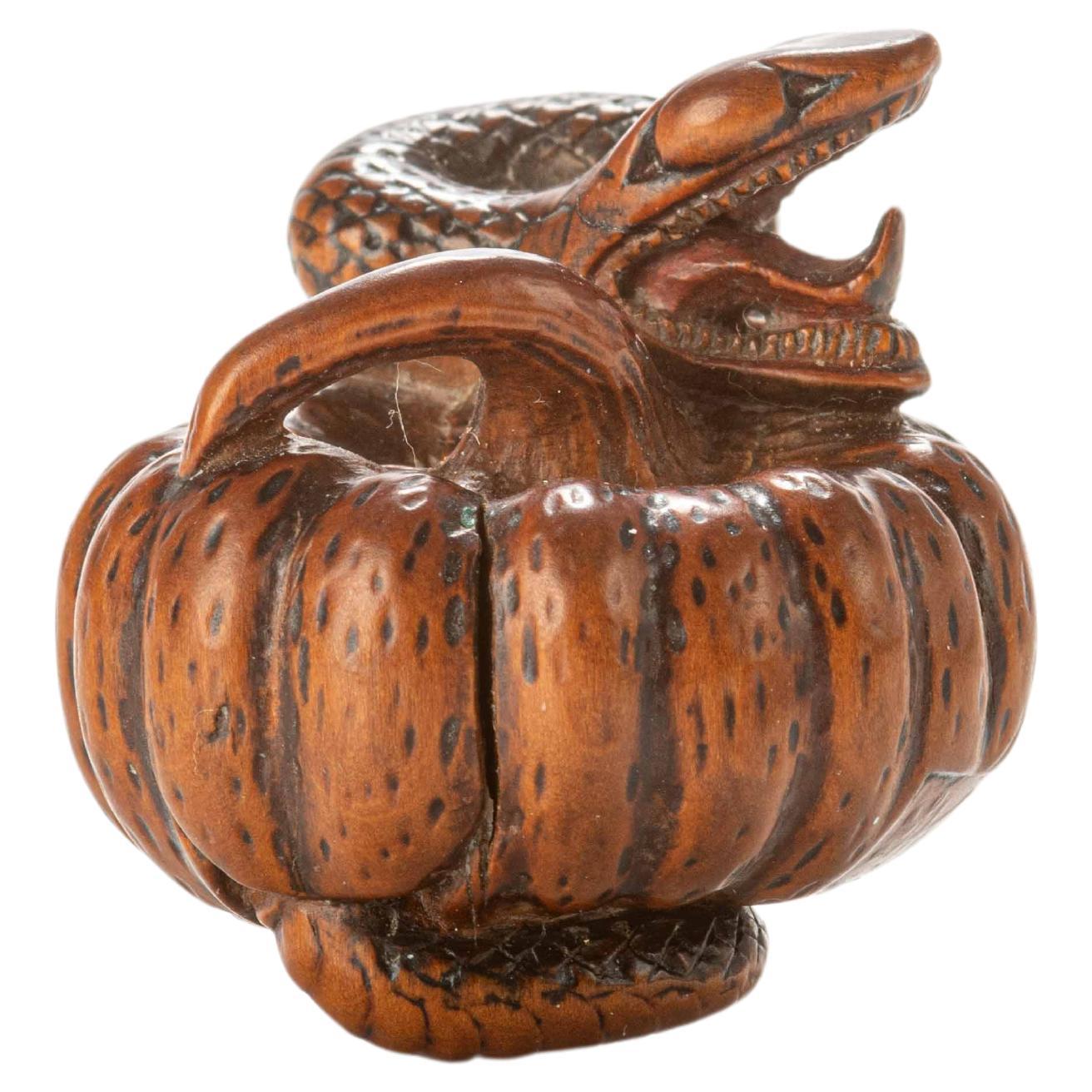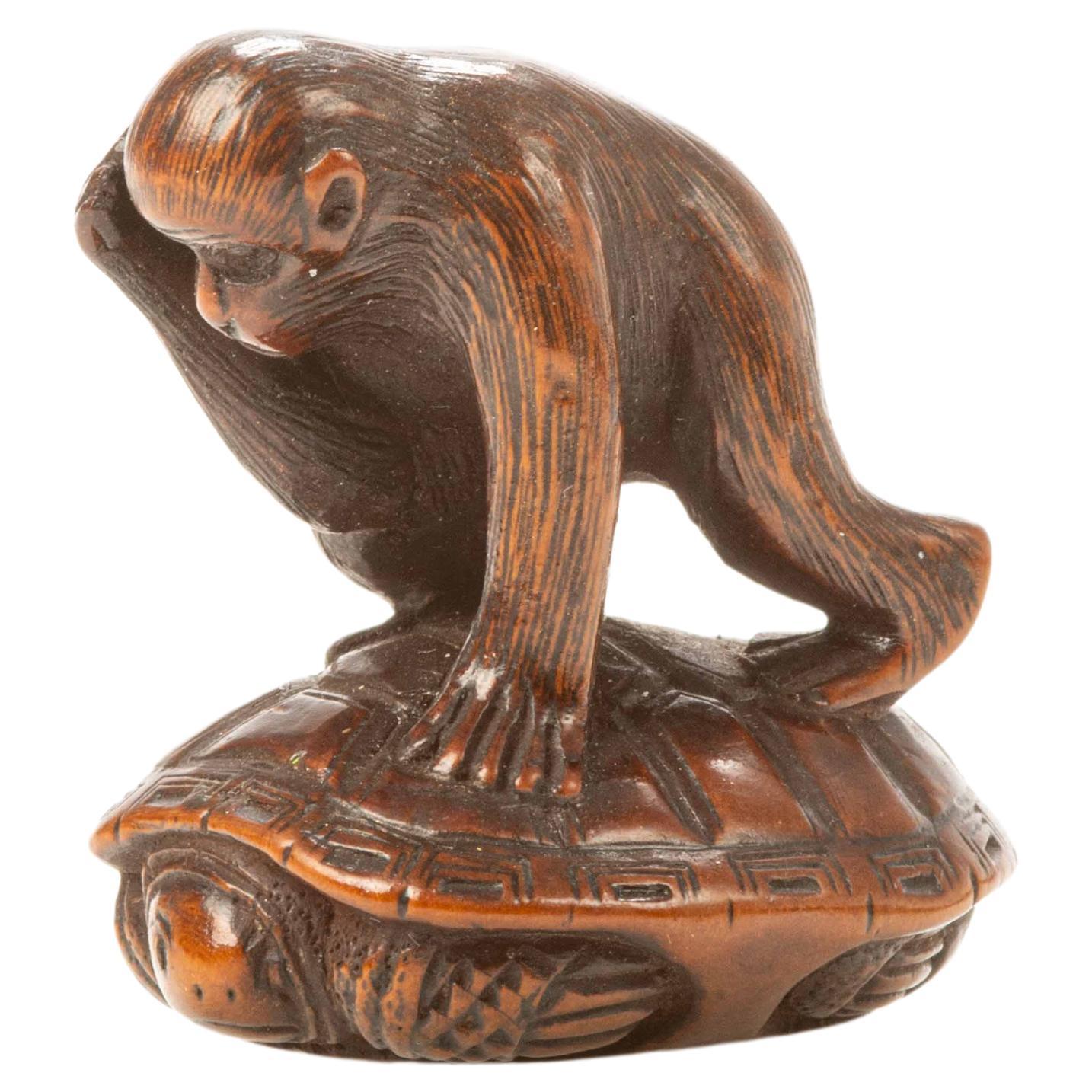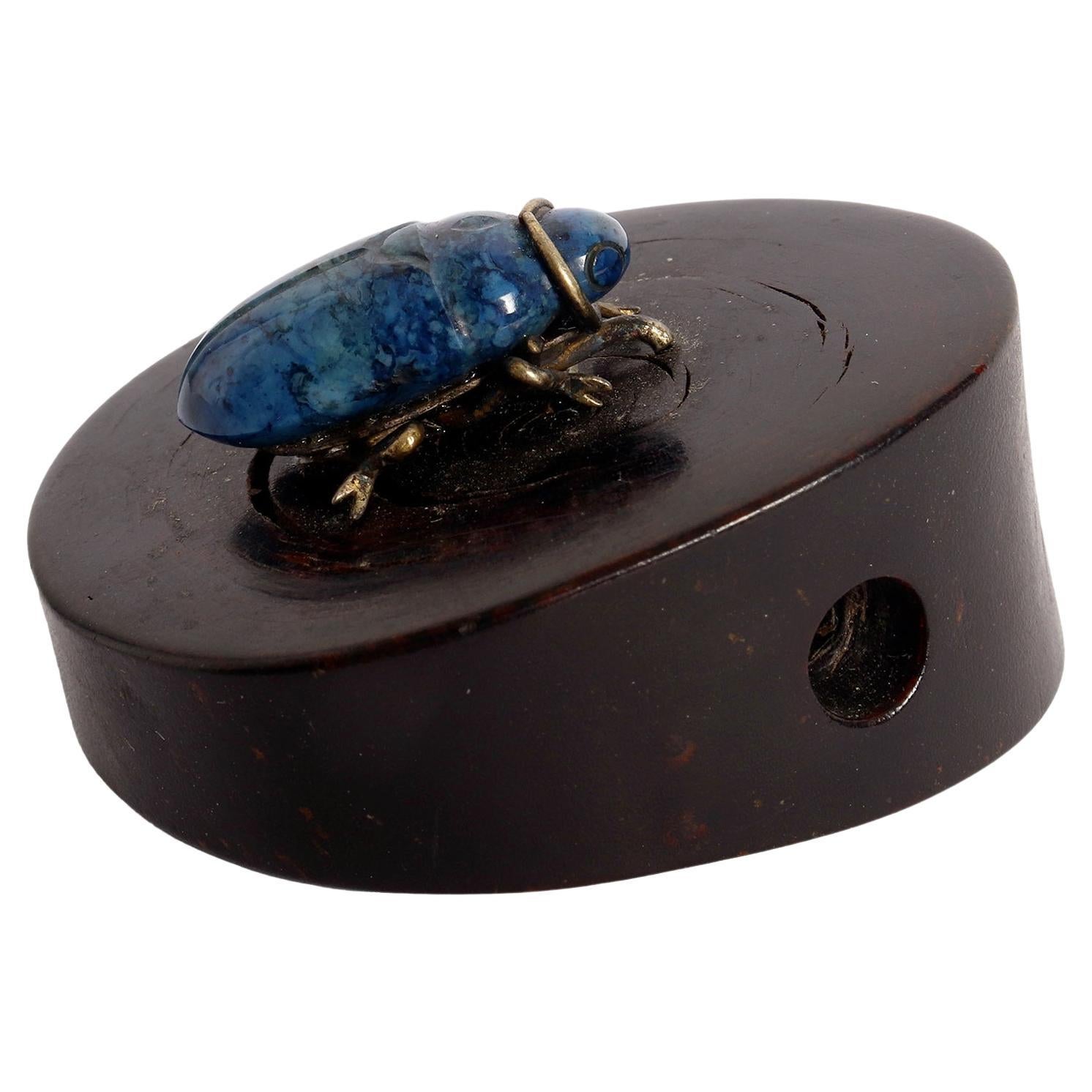Items Similar to Saishiki netsuke of Ryujin
Want more images or videos?
Request additional images or videos from the seller
1 of 9
Saishiki netsuke of Ryujin
About the Item
Saishiki netsuke of Ryujin
Style of Yoshimura Shuzan, 18th century
Signed: Shuzan
Height: 9,8 cm
Provenance:
W. L. Behrens collection, no. 311
Literature:
H. L. Joly, W. L. Behrens Collection. Part I Netsuke and Japanese Carvings, London: Glendening, 1912, plate XLII
G. Lazarnick, The Meinertzhagen Card Index, New York: Alan R. Liss Inc., 1986, p.802
The Dragon King, or one of his emissaries, is shown with a fierce expression, holding a dragon in his right hand and a Tama, the sacred tide jewel, in his left. This example is in the style of Yoshimura Shūzan of Osaka, a Kanō school painter of the mid-eighteenth century, who, according to the Sõken Kishō, Inaba's 1781 publication, was considered one of the finest carvers of his day. He is the innovator in netsuke of legendary and mythological figures done in this technique: his carvings, which he created using hinoki (cypress) wood, were coated in a kind of plaster and painted in polychromy. Because of his popularity among the public, subsequent generations of artists tried to imitate his style, which led to Nagamachi Shuzan, who signed his name "Shuzan" in honor of the style's creator, producing a sizable number of vibrantly colored netsuke in the late 19th century.
The Meinertzhagen Card Index lists this netsuke as by Nagamachi Shuzan, but it seems that the style of this later netsukeshi differs greatly from this one, favoring theatrical and everyday topics and producing netsuke that are half the size of this one. We can then assume that there was a different maker who signed as "Shuzan" or that the signature here was added later.
- Dimensions:Height: 3.86 in (9.8 cm)Width: 0.79 in (2 cm)Depth: 1.19 in (3 cm)
- Materials and Techniques:
- Period:
- Date of Manufacture:circa 1850
- Condition:
- Seller Location:Milano, IT
- Reference Number:1stDibs: LU4250239213952
About the Seller
5.0
Recognized Seller
These prestigious sellers are industry leaders and represent the highest echelon for item quality and design.
Established in 2005
1stDibs seller since 2018
10 sales on 1stDibs
Typical response time: 1 hour
- ShippingRetrieving quote...Ships From: Milano, Italy
- Return PolicyA return for this item may be initiated within 7 days of delivery.
More From This SellerView All
- Large Wood Netsuke of a ShishiLocated in Milano, ITLarge wood netsuke of a shishi Kyoto school, 18th/19th century Height: 5.7cm The large netsuke with a very nice patina, showing the mythical creatu...Category
Antique 18th Century Japanese Sculptures and Carvings
MaterialsWood
- Pair of Japanese Screens with Flowers of the Four Seasons, 19th CenturyLocated in Milano, ITThis pair of screens belongs to a genre of lyrical paintings of flowers, grasses, and other plants that flourished around the middle of the 17th century and became a specialty of the Sôtatsu studio. The use of a rather complex composition of clusters of flowers and the puddling of ink was initiated by Tawaraya Sôtatsu, the founder of the Rimpa School, who was active from 1600 until 1642. The screens are abstract and decorative but there is, at the same time, a keen sense of naturalism not only in the attention to accurate detail but in the profusion of vegetation. The passage of the year is symbolized by the variety of plants that bloom in different seasons. The tarashikomi - here used on leaves, petals and trunks - is a Classic Rinpa technique in which pale black ink or a color is brushed onto an area of a painting and then either darker ink, or the same or a contrasting color, is dropped into the first before it has completely dried, creating an effect of pooled colors with softly blurred edges. Its delicacy, preciousness, and effeminacy are identified with the over-refinement of its patrons, while the vigor, monochromatic discipline, sharp observation, and virile forms of the Kano school are a testament to the vitality of the rising warrior class. The plants are almost all identifiable: in the summer-spring part, you can find wheat, buttercups, irises, begonias, hydrangeas, coral bells...Category
Antique 19th Century Japanese Paintings and Screens
MaterialsPaper
- Kogo in the Shape of a DeerLocated in Milano, ITHiramaki-e lacquer, nashiji and fundame Edo period, 19th century Length: 10.5 cm, height: 6.5 cm Since the Heian period, The theme of deer and autumn plants has been ut...Category
Antique 19th Century Japanese Lacquer
MaterialsWood
- Shunichi Yabe Kofu #3, Wind of Light, Bizen Stoneware, 2013Located in Milano, ITWhat is immediately striking about the work of Yabe is his keen and natural sense of line. The artist, in fact, takes great care in first drawing an image of the work, and after hand-building the basic form a blend of Bizen mountain and rice-paddy clays, the work is carved with a knife into the form he had envisioned. After carving, the work is first bisque-fired and then its main-firing is executed in a small wood kiln for 3 days at a temperature reaching 1180 degrees. The resulting futuristic forms of Yabe’s stoneware present fresh new possibilities for Japanese Bizen clay in the 21st century. Shunichi Yabe...Category
21st Century and Contemporary Japanese Ceramics
MaterialsCeramic
- Jizai Okimono, Russet-Iron Articulated Figure of a CrabLocated in Milano, ITJizai Okimono A russet-iron articulated figure of a crab Edo Period (1615 - 1867), 19th Century Length: 15 cm with extended limbs The iron crab...Category
Antique 19th Century Japanese Metalwork
MaterialsIron
- Japanese Wooden Buddhist Sculpture of Amida Nyorai, 16th CenturyLocated in Milano, ITThe Amitabha (Amida in Japanese) Buddha is shown standing with his hands forming the Amida raigo-in mudra. The face has a serene expression, with closed eyes under delicately arched brows and a severe face. The hair is arranged in rows of coils that also cover the "ushnisha", the protuberance on the head. The drapery is folded in elegant pleats falling from the shoulders to the feet. The antique sculpture is placed on a lotus flower which is located on a richly decorated base. Faith in Amida Buddha remained largely confined to a small segment of the Japanese population until the Kamakura Era (1185-1333) when it was popularized by new Pure Land sects committed to bringing Buddhism to the illiterate commoner. These sects expressed concern for the salvation of the ordinary person and stressed pure and simple faith over complicated rites and doctrines. Amida Nyorai...Category
Antique 16th Century Japanese Sculptures and Carvings
MaterialsWood
You May Also Like
- A boxwood netsuke depicting a snakeLocated in Milano, ITBoxwood netsuke depicting a snake coiled around itself. Signature engraved under the base. Origin: Japan Period: Meiji late 19th century. Dimensions: 4 x 3.5 x 2 cm. State of co...Category
Antique 19th Century Japonisme Antiquities
MaterialsBoxwood
- A boxwood netsuke depicting a snake wrapping around a pumpkinLocated in Milano, ITBoxwood netsuke depicting a snake wrapping around a pumpkin. The snake is a symbol often associated with rebirth, transformation while the pumpkin is a symbol of fertility, abundanc...Category
Antique 19th Century Japanese Japonisme Antiquities
MaterialsBoxwood
- A Japanese boxwood netsuke depicting a Dutchman with a childLocated in Milano, ITBoxwood netsuke depicting a Dutchman with a child on his shoulder and a trumpet. Excellent blond patina on the front contrasting with the darker part on the back. Large himotoshi h...Category
Antique Mid-18th Century Japanese Japonisme Antiquities
MaterialsBoxwood
- A Boxwood Netsuke Depicting A Toad Resting On A SandalLocated in Milano, ITBoxwood netsuke depicting a toad resting on an upside-down sandal (waraji), with horned eyes. Signed Masanao on a rectangular gusset in the center of the sandal. Origin: Japan Per...Category
Antique Early 19th Century Japanese Japonisme Antiquities
MaterialsBoxwood
- A boxwood netsuke depicting a monkey trying to catch a turtleLocated in Milano, ITA boxwood netsuke depicting a monkey trying to catch a turtle, which retracts its head and legs inside the carapace. Origin: Japan Period: Edo 19th century. Dimensions: 3.4 x 3 x ...Category
Antique Early 19th Century Japanese Japonisme Antiquities
MaterialsBoxwood
- Black Horn Netsuke, Japan, Meiji Period, Around 1870Located in Milan, ITBlack monochrome horn netsuke emulating an asymmetrically sectioned tree trunk. Along the top climbs an insect carved in lapis lazuli and finished with gold details. Japan, Meiji per...Category
Antique Late 19th Century Japanese Antiquities
MaterialsLapis Lazuli
Recently Viewed
View AllMore Ways To Browse
Astrology Dress
Hallmark Fm Russia
La Belle China Enamel
Tibetan Gong
Mid Century Floor Lamp With Shade
1950s Wall Light
Two Mid Century Couches
Italian Wall Art Wood
19th Glass Display
Powder Coat Table Base
Coffee Table X On Top
Porcelain Vessels White
1940s Country Style Furniture
Chair Sets On Sale
Mid 20th Century Japanese
Jean Button
Brass And Glass Small Chandelier
Vase Plate





